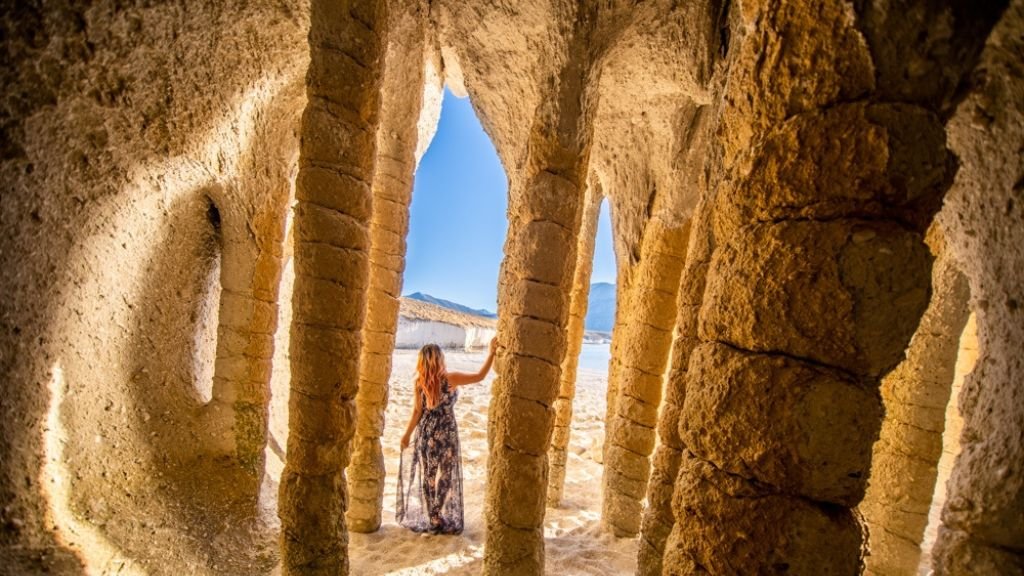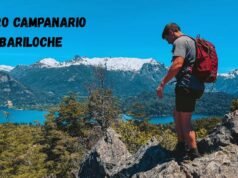The Crowley Lake Columns, sometimes referred to as the Crowley Lake Columns Tuff or the Columns of the Giants, are a distinctive geological formation found along the eastern shore of Crowley Lake in Mono County, California, in the Eastern Sierra region of the United States.
These unique structures, which can reach heights of up to 20 feet and are linked by towering arches, evoke images of the ruins of an ancient Moorish temple. These spectacular columnar formations, characterized by their symmetrical patterns, continue to draw the curiosity of both scientists and tourists alike.
History of Crowley Lake Stone Columns
The magnificent stone columns of Crowley Lake Columns remained concealed for centuries, buried beneath layers of pumice and ash. The relentless lapping of Crowley Lake’s waves gradually eroded the softer materials at the base of the cliffs, unveiling these remarkable formations. Spanning a 2-3 mile radius, the area boasts over 5,000 of these columns.
Clustered together, the columns at Crowley Lake vary widely in shape and size, yet many share a common feature: distinct horizontal bands, roughly a foot apart. Despite many columns being visible, numerous others remain partially submerged beneath the sand.
Researchers from UC Berkeley explain that these columns formed nearly 760,000 years ago following a massive volcanic eruption. Melting snow trickled down into the hot volcanic ash, boiling on contact and forming evenly spaced convection cells akin to heat pipes. These voids were solidified by minerals, which hardened and became resilient enough to withstand the erosive forces of wind and the lake’s waves.
Discovery and Historical Significance of Crowley Lake Columns
The columns were largely unknown until the creation of Crowley Lake in 1941 when the area was flooded as part of a water storage project. Their exposure fluctuated with the water levels, but it wasn’t until the severe droughts that lowered the lake’s waterline that the full extent of the columns was revealed. The site does not have recorded Indigenous significance, but it’s a focal point for local historical narratives related to geological research and environmental changes.
The Crowley Lake Columns, towering as high as 20 feet, are predominantly hexagonal in shape, although some display different polygonal configurations. These pillars are neatly packed in dense clusters that extend along the lakeshore, creating a labyrinthine network of natural corridors that captivate photographers and geologists alike.
Related: Mendocino Things to Do
How to Get to Crowley Lake columns?
Getting to the Crowley Lake Columns requires some planning as access isn’t straightforward year-round. The columns are located on the eastern shore of Crowley Lake, just south of Mammoth Lakes in California. During the drier months, typically from late summer through fall, the water levels in Crowley Lake recede enough to expose the columns, making this the best time to visit. To reach the columns, you must navigate a network of dirt roads that branch off Benton Crossing Road.
Using a vehicle with high clearance is advisable since the roads can be rough. Once you’re near the area, a short hike will take you down to the shores where the columns stand. Remember that the land around Crowley Lake is managed by the Los Angeles Department of Water and Power, so it’s important to check for any access restrictions or required permits before planning your visit.
Activities Around Crowley Lake Columns

Beyond the columns, Crowley Lake offers a variety of outdoor activities. Anglers enjoy trout fishing, while hikers and nature lovers explore surrounding trails offering breathtaking views of the Eastern Sierras. The lake’s clear waters and scenic surroundings make it a popular spot for kayaking and paddleboarding.
Here’s a look at some of the engaging activities you can enjoy around Crowley Lake Columns:
Fishing:
Crowley Lake is a renowned fishing destination, especially known for its excellent trout fishing. Anglers can try their luck catching Rainbow, Brown, and Cutthroat trout. The lake hosts the Crowley Lake Fish Camp, which provides boat rentals and services for a complete fishing experience.
Hiking:
The area around Crowley Lake is dotted with numerous trails that offer breathtaking views of the Sierra Nevada mountains and access to remote wilderness areas. Popular hiking spots include the Hilton Lakes Trail, McGee Creek Trail, and the Convict Lake Trail, each offering unique landscapes and varying difficulty levels.
Bird Watching:
The lake and its surrounding areas serve as a habitat for various bird species, making it a fantastic spot for bird watching. Seasonal migrations add to the diversity, where you can spot grebes, ospreys, and even bald eagles.
Photography:
Crowley Lake is a photographer’s paradise with its stunning landscapes that change with the seasons. The Crowley Lake Columns, in particular, provide a unique geological feature perfect for dramatic landscape shots, especially during the golden hours of sunrise and sunset.
Water Sports:
During the summer, the lake is ideal for water sports, including kayaking, canoeing, and stand-up paddleboarding. The lake’s calm waters make it a safe and enjoyable place for paddling and exploring its extensive shoreline.
Camping:
There are several campgrounds around Crowley Lake, such as the Crowley Lake Campground and McGee Creek Campground, which offer facilities for both tent and RV camping. Camping is a great way to immerse yourself in the area’s natural beauty and enjoy stargazing away from city lights.
Winter Sports:
In the winter, the area around Crowley Lake transforms into a snowy retreat. While the lake itself freezes over, nearby areas offer snowshoeing and cross-country skiing opportunities. The close proximity to Mammoth Mountain also makes it easy for visitors to access downhill skiing and snowboarding.
Cultural and Historical Exploration:
While the natural beauty is a big draw, the area also has cultural and historical sites, such as the nearby town of Mammoth Lakes, which offers insight into the local history and culture of the Eastern Sierras.
Rock Climbing:
For the more adventurous, the surrounding Sierra Nevada mountains offer several rock climbing opportunities. The Benton Crags, for example, provide challenges for climbers of various skill levels.
Whether you’re seeking tranquility by the water’s edge, an adventurous hike in the mountains, or simply a place to relax under the stars, Crowley Lake offers activities that cater to all preferences and ages, making it a versatile destination for a day trip or an extended stay.
Read More: Top 10 Best Luxury Hotels & Resorts in Miami
Planning Your Visit to the Crowley Lake Columns
If you’re planning a trip to the Crowley Lake Stone Columns, thoughtful preparation can greatly improve your experience at this impressive geological site. Here are some practical tips to optimize your visit:
- Timing: Evaluate the weather conditions and select the best season for your trip. Spring and summer are ideal for hiking, while autumn offers a display of colorful foliage. Winter can be quite chilly, so dress accordingly.
- Directions: To find the columns, use GPS coordinates or a detailed map, as they are located off Benton Crossing Road near Crowley Lake.
- Accessibility: Access to the site is relatively easy through a well-maintained dirt road that is accessible by most types of vehicles, though caution is advised under poor weather conditions.
- Footwear: Opt for comfortable hiking boots or durable shoes to navigate the uneven terrain around the columns comfortably.
- Safety: Be cautious when climbing or navigating around the columns, as the basalt rocks can be slippery. Always adhere to any posted signs and guidelines to ensure your safety during the visit.
- Photography: Remember to bring a camera or smartphone to capture the striking geological formations and the beautiful landscape. The best light for photos is typically early in the morning or late in the afternoon.
- Supplies: Pack essentials such as water, snacks, sunscreen, and a hat, particularly in the warmer months. If you’re planning a longer hike, bring a backpack with additional supplies.
Keep in mind, that there are no amenities on the drive to or at the site itself. Situated between Bishop and Mammoth Lakes, the area’s remoteness often provides a serene, isolated environment for visitors.
READ: Things to Do in Yosemite
Tips for a Crowley Lake Columns Memorable Experience
To make the most of your visit to the Crowley Lake Stone Columns, consider the following tips:
- Choose a time to go when the weather is agreeable.
- Make sure to follow the directions closely to find the location.
- Dress appropriately, especially sturdy footwear, and proceed carefully while navigating the area.
- Pack necessary supplies for your outing.
- Be mindful of the environment and adhere to any guidelines provided.
- Opt for guided tours to gain a deeper understanding of the area.
- Take plenty of photos to capture your experience.
- Enjoy the quiet and the ancient natural formations.
- Take time to ponder the enigmatic and awe-inspiring nature of the site.
How were the Crowley Lake Columns Formed?
The formation of the Crowley Lake columns is a fascinating tale of natural forces at work. These striking geological features were created through a combination of volcanic activity and erosion. About 760,000 years ago, a massive volcanic eruption in the Long Valley area deposited hot ash across the region. As this layer of ash cooled and hardened, it formed what geologists call tuff, a type of solidified volcanic ash.
Over thousands of years, water from melting snow seeped down through cracks in the tuff, eroding the softer material and leaving behind the harder material in distinct, columnar shapes. These processes sculpted the tuff into tall, hexagonal columns, which were eventually exposed as the waters of Crowley Lake receded. Today, these columns stand as natural testaments to the dynamic geological history of the Eastern Sierra region.
Read Also: Best Hotels with Jacuzzi in Room Miami
Scientific Research and Studies
Scientific interest in the Crowley Lake Columns has spiked in recent decades. Studies primarily focus on their formation process and how they have withstood the erosive forces that have exposed them so dramatically. Research findings contribute significantly to the broader understanding of geological processes in volcanic areas.
Conclusion
The Crowley Lake Columns are a testament to nature’s artistic prowess and the dynamic geological history of California. They offer a unique glimpse into the natural forces that shape our world, making them a must-visit destination for anyone fascinated by Earth’s geological wonders. Whether you’re a seasoned geologist, a nature enthusiast, or simply a curious traveler, the Crowley Lake Columns promise an unforgettable experience.
To Know More: Best Things to Do in North Carolina in 2024
Frequently Asked Questions (FAQs) about Crowley Lake Columns
Here are frequently asked questions about the intriguing Crowley Lake Columns, providing insights for those planning to explore this unique geological feature:
What are the Crowley Lake Columns?
The Crowley Lake Columns are a series of mysterious stone pillars located along the shores of Crowley Lake in California. They are noted for their striking vertical formations and symmetrical patterns, created by natural geological processes.
How were the Crowley Lake Columns formed?
The columns were formed nearly 760,000 years ago from a massive volcanic eruption that deposited hot ash in the area. Over time, melting snow seeped into this ash, boiling and creating evenly spaced convection cells that eventually hardened into the columns seen today.
Can I visit the Crowley Lake Columns?
Yes, the columns are accessible to the public, but reaching them can be challenging, especially when the water level in Crowley Lake is high. Access is typically easier in late summer and early fall when water levels recede.
Do I need permission to visit the columns?
It’s advisable to check current access restrictions before planning your visit. The area around Crowley Lake is managed by the Los Angeles Department of Water and Power, and at times, access may be limited to protect the natural environment.
What is the best time of year to visit the Crowley Lake Columns?
The best time to visit is between late summer and early fall when the water levels in the lake are lower, exposing more of the columns. This period offers easier access and better opportunities for photography.
Are there any tours available to see the Crowley Lake Columns?
While there are no regular tours specifically dedicated to the columns, local tour operators around Mammoth Lakes offer guided trips that include the Crowley Lake Columns as part of broader sightseeing activities in the region.
What should I bring when visiting the Crowley Lake Columns?
Prepare for a potentially rugged trip with appropriate hiking gear, plenty of water, sun protection, and a camera to capture the columns’ natural beauty. Also, consider bringing a detailed map or GPS device, as the area can be tricky to navigate.
















[…] Related: Crowley Lake Columns […]
Comments are closed.